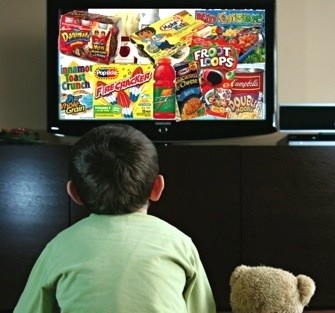Teens’ TV Time Linked to Unhealthy Eating
Wednesday, May 23, 2012

The link between TV watching and obesity demonstrated by new research.
This information adds weight to a growing body of work regarding the health impact of television viewing. According to the study's authors, television viewing (TVV) by young people has been associated with unhealthy eating and food choices that may track into early adulthood. "Young people in the US fall short of recommendations for whole fruit, whole grains, legumes and dark green or orange vegetables, while exceeding recommendations for fat, sodium and added sugar that can increase the risk of obesity and chronic disease throughout a lifetime," according to primary authors Leah M. Lipsky, Ph.D., M.H.S., and Ronald J. Iannotti, Ph.D., of the Eunice Kennedy Shriver National Institute of Child Health and Human Development in Bethesda, MD.
TV time linked to more candy and sugar-sweetened soda
"Television viewing time was associated with lower odds of consuming fruit or vegetables daily and higher odds of consuming candy and sugar-sweetened soda daily, skipping breakfast at least one day per week and eating at a fast food restaurant at least one day per week in models adjusted for computer use, physical activity, age, sex, race/ethnicity and family affluence," according to the authors. "The relationship of TVV with this unhealthy combination of eating behaviors may contribute to the documented relationship of TVV with cardiometabolic risk factors."
Hasbro expert Elissa Jelalian, PhD
Elissa Jelalian, Ph.D. from the Bradley Hasbro Children's Research Center, sees these results as relevant. "The study provides important information regarding the well-documented relationship between television viewing time and increase in BMI in pediatric populations," she said. According to Dr. Jelalian, the study identifies some of the eating and activity behaviors (consumption of sugar-sweetend beverages and candy) that may explain the relationship between TV viewing and obesity. "Given the amount of time that the average teens spends watching television, understanding and addressing the reasons for this association may be a very promising avenue for reducing obesity risk in this age group," she said.
Risk of sweets goes up with age
According to the results, the odds of eating fruits and vegetables daily were higher for younger than older students, for girls compared with boys, and for white students and other groups compared with black and Hispanic youth. The odds of eating sweets daily were highest for older than younger youth, for girls compared to boys and for black youth compared with other racial/ethnic groups.
The results also indicate that the odds of drinking soda at least daily were highest for older versus younger youth, for boys versus girls and for black and Hispanic young people compared with other racial/ethnic groups. Skipping breakfast was more common for older than younger students, for girls compared with boys and for black, Hispanic and other youth compared with white students.
Does advertising play a role?
"Future research should elucidate the independent contributions of TVV, food advertising and TV snacking on dietary intake in this population," the authors conclude. "If these relationships are causal, efforts to reduce TVV or to modify the nutritional content of advertised foods may lead to substantial improvements in adolescents' dietary intake."
The researchers used data from the 2009-2010 Health Behavior in School-Aged Children Study, a survey of adolescents conducted every four years in the U.S. The survey included a nationally representative group of 12,642 students in the fifth through 10 th grades with a mean (average) age of 13.4 years.
Related Articles
- Innovative Program Teaches Young Children to Write Music
- Family Matters: 12 Ways to Keep Kids Busy Over Break
- Enjoy Live Music and Beautiful Flowers with Your Woo Card
- Great Deals on Live Music With Your Woo Card




 Delivered Free Every
Delivered Free Every
Follow us on Pinterest Google + Facebook Twitter See It Read It